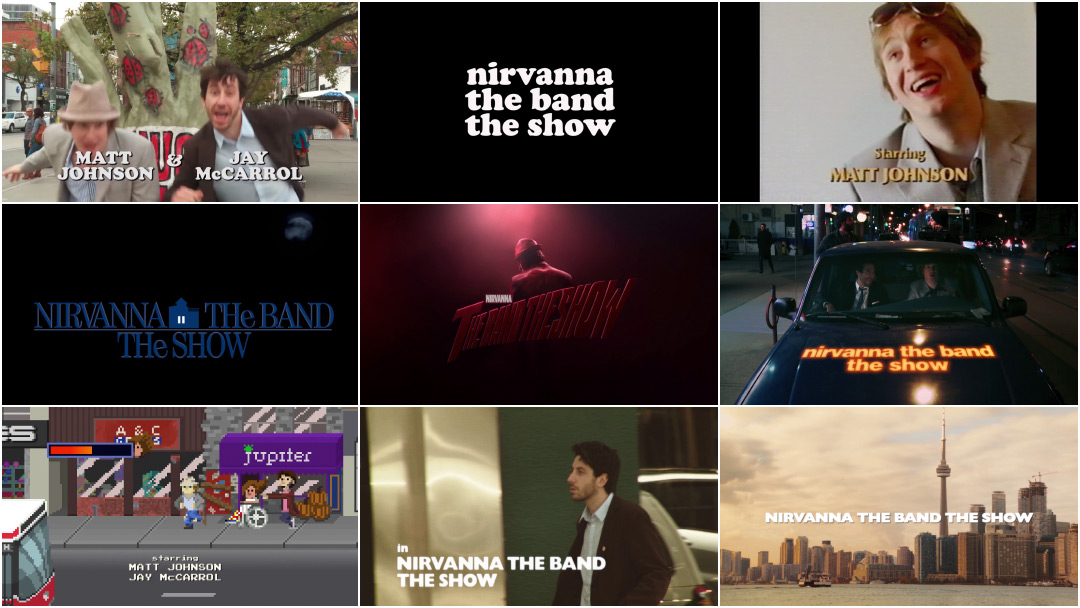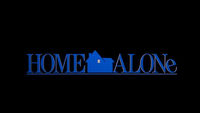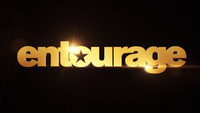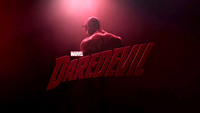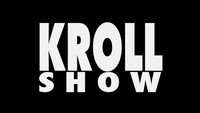What do Growing Pains, Home Alone, Daredevil, Entourage, Crank, My Dinner with Andre, and Dog Day Afternoon have in common? Absolutely nothing... That is, until Nirvanna the Band the Show came along.
When co-creators Matt Johnson and Jay McCarrol were shooting Viceland’s first ever scripted series, there was one thing that kept the show’s highly improvised plots anchored: the title sequences. Every episode of Nirvanna the Band the Show inserts the main characters into a parody of a familiar opening credit sequence. It’s their way of worldbuilding in a show that can spin off in just about any direction, but sooner or later the choice of opening leads to an “aha” moment within the episode. As consummate consumers of film and TV content, Johnson and the team at Zapruder Films throw in everything from ‘80s sitcoms to retro video games, trashy action flicks and classy art films, letting the viewer make what they will of the insane post-postmodern smorgasbord.
And these are not scrappy versions of the sequences either, but slick, well-produced replicas created completely from scratch, juxtaposing the show’s decidedly DIY aesthetic. Homage is too serious a word, yet to label them as simple parodies doesn’t do them justice either. Nirvanna’s version of the Daredevil opening apes the complex fluid simulation of Elastic’s original, but adds devil sticks and an ill-fitting fedora. Their Entourage opener pins credits to familiar landmarks – swapping Los Angeles for Toronto. Their pixelated Crank sequence needs to be seen at least eight times to process all the mayhem, and their My Dinner with Andre opening switching the continental cuisine of Café des Artistes for the egg rolls and chicken balls of the vaunted Mandarin Chinese buffet.
Every effort is made to make the sequences look and feel like the originals, from navigating fair use law for music rights, to transferring footage to 16mm to make the classic film sequences feel more cinematic. No detail is too small, no reference too obscure. Perhaps none more obscure than the first episode, which is a shot-for-shot recreation of the opening titles from the 2007 web series Nirvanna the Band the Show is based upon.
A discussion with Co-Creators MATT JOHNSON and JAY MCCARROL, Title Designer JOSH SCHONBLUM, and VFX Supervisor TRISTAN ZERAFA.
So going into this project did you always know you were going to do title sequences based on existing ones?
Matt: Yes. For whatever reason that was so important to us when we made the web show. I don’t even know why. I think because the show was trying to play on television tropes and we were such fans of what was on TV. I think we thought it would help us with where the stories would start. This can be like The Wire or this can be like The Wonder Years. It would help us, we could add aesthetic things to the storytelling that normally a show can’t do without seeming very hokey.
Jay: It allows you to get very referential. We’ve always done a lot of scenes that impersonated other scenes, so it was natural as soon as we got carried away with something. Back in the web show days it would be literally what the thing was at the time. We were obsessed with The Wire at that time, so the episode that we shot, we just could not stop doing Wire quotes.
We could add aesthetic things to the storytelling that normally a show can’t do without seeming very hokey.
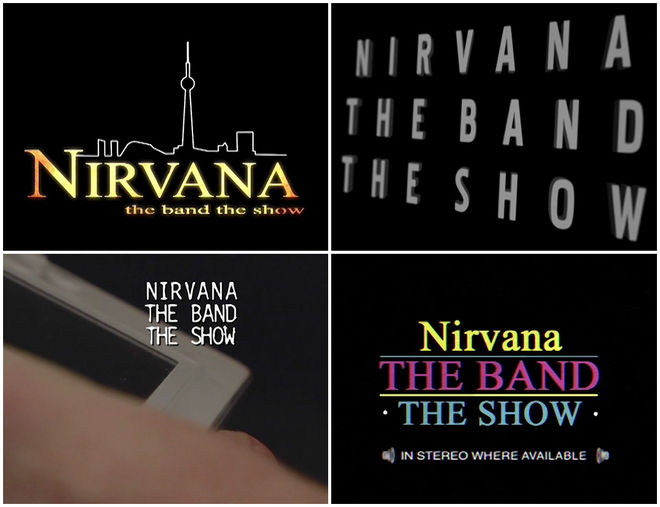
Image set: Title cards from the original Nirvana the Band the Show (2007) web series
Did you go into this season with a big list of sequences you wanted to do?
Matt: We had a list, but because we’re working with a much bigger team now it was more about what could fit the story more so than what we’re watching right now. Now we’re using it as a much more of a narrative tool than we were in the past. I’m trying to think of the best example we have in season one. Maybe the Entourage credits where we do this really huge Entourage-style episode? Jay and I aren’t big fans of that show, nor are we really big fans of Daredevil. Now we’re having the title sequences try to match the story rather than having it match whatever it is we’re obsessed with.
Jay: It does work both ways. We can go in going oh, we know exactly how we want this to be, we want it be a Star Wars-based episode with Daredevil mixed in, or we have it going and we don’t know what the parody of something is going to be and that can end up helping with the writing. Episodes will be written in a certain way and it still needs some other counterpoint to make the stories collide or make characters have a little bit of journey.
Matt: Or just give us an excuse to do bad storytelling sometimes. In an episode that we’re doing now where we kidnap a kid from Sick Kids [Toronto’s Hospital for Sick Children], the parody that we thought we were doing wound up opening up all this new story space that wasn’t there before. We had a completely different plot that was totally changed by the opening credit sequence, so we use it a creative tool the same as everything else.
And which sequence is that?
Matt: It was supposed to be Crank because this kid has got a bad heart. We were gonna make it like this kid is going to slowly have a heart attack throughout the episode but then we moved the story away from that – away from him having a heart attack to just being concerned about his heart – but still wanting to have this really amazing 8-bit opening.
Crank (2006) main titles, animated by Brian Taylor
Matt: So we have this sequence but didn’t want to do the Crank parody anymore, so it forced us to figure out how we could make this 8-bit video game stuff relevant to the plot. It pushed the story in a completely different direction. The fact that we can turn that into something that we use rather than being like, “Okay, I guess we just abandon these elements and move on and do something else,” it’s almost the same way that Jay and I improvise the story. We’ll also improvise in post where something won’t quite work and it’ll shift gears. Sometimes that leads to a whole lot of wasted time – often it does – but we wind up doing things that we never expected we would do and weirdly enough those opening credit sequences are a big part of that, because they’re one of our anchors.
Tristan or Schonblum devote so many hours to doing it. When it’s done we know we’ve got this piece, like this Daredevil piece, we know we’ve got that, so it’s something that we can kind of rest on and be like, “Okay, well that means we really have to push the Daredevil stuff in this episode” or “We really need to push the Entourage stuff.” In the Crank thing we thought the Crank stuff isn’t working. We need to figure out a way to justify this, so let’s rewrite to try to make that work. It’s nice having, not tent poles, but like really solid legs of a table and those opening credit sequences have been really important for that. It’s so easy to get lost in this when you can just do whatever you want, whatever story you want, and at any point completely rewrite it. It’s good to have those two or three things that you know are fixed.
Is it because they take so much longer to produce than anything else that they’re what needs to be settled on first?
Matt: Exactly! They’re one of the few things we do in the show that actually requires execution of a specific vision. With the Daredevil sequence, Tristan has been working on it for what seems like months.
[Daredevil is] such an awesome counterpoint to the way that we make the rest of the show.
Nirvanna the Band the Show (2017) title sequence done in the style of Daredevil (2015)
Tristan: It’s been two months, but I had to do about six months of research in order to learn the tools necessary to execute the task.
Matt: And that’s such an awesome counterpoint to the way that we make the rest of the show. We get an idea one minute, we’ll shoot it the second minute, we’ll edit the third minute, and then throw it out and completely change it. It’s literally the exact opposite. The way Jay and I are working in the scenes couldn’t be further from what we’re doing to make these opening credit sequences, which is a really, really nice balance.
The Daredevil sequence seems by far to be the most ambitious, what did you have to learn in order to execute it?
Tristan: Well, it actually started on your website. Just learning from the people that actually did it. I read the interview and everything online that had to do with Elastic’s project, and even tried to track down Miguel A. Salek who had done the original fluid simulations. I itemized all the software that they mentioned, little tidbits of information when they’re talking about different settings that they use in RealFlow specifically.
Comparison: Nirvanna the Band the Show episode 4 title sequence (left) and the Daredevil title sequence (right)
Tristan: Before I found those articles I tried to use a software called Bifrost and it just wasn’t giving the same kind of aesthetic, so RealFlow was definitely the choice. I hadn’t used RealFlow in ten years, so it was a relearning of that entire workflow from the ground up.
I rewatched the original Entourage sequence and it’s much longer than yours. Where do you draw the line between being true to the original sequence and just doing what you think is right for the show?
Josh: Well, we start doing shot for shot. We actually have a full version of that Entourage sequence that’s the exact same length and contains all the same shots. That’s how all of them originally start but every single episode we’ve had to cut for time.
Tristan: Thank god!
The Entourage sequence is so brutal. It’s so dated.
Entourage (2004) season 8 main titles, designed by Brown Bag Films
Matt: There’s a really cool secret in that, because we cut them not just for time but because our fair use, what legally covers us doing this, only lasts for about 35 to 40 seconds. You don’t have the legal right to do this type of parody for an extended period of time beyond making the point, so we wouldn’t be able to release these things at the exact length. Like this Daredevil sequence is maybe half of the length of Daredevil’s opening credits, but we still try to evoke as much as we can from the original sequence. Another thing that you’ll notice if you look at the Entourage credits and then ours side by side, they’re like a hundred times better. The Entourage sequence is so brutal. It’s so dated.
Nirvanna the Band the Show (2017) title sequence done in the style of Entourage (2004)
Josh: We went frame by frame and we realized the effects were done really shoddily. They just put black masks over things and put in titles. It’s a really poorly done opening.
Matt: And yet, what’s funny is if you show ours to people, they just go “Yeah, that’s exactly like Entourage. The exact same.” They never see a quality difference at all.
How did you decide whose names would be on what Toronto locations?
Matt: Schonblum decided that. Didn’t you?
Jay: I didn’t have a say. I’m a little Japanese restaurant and Matt’s the Skydome.
Hey, I love Sushi on Bloor!
Matt: Yeah, I know!
Josh: For that one it was specifically names that would fit in the space and not be weird, but also letters that would match up. Certain billboards have letters that you recognize and if you have a name that has none of those letters then it would look weird.
Tristan: I ran into that font issue too with Daredevil. I had so many letters to compact into this small area. It was super tough, I’ve never thought about that being a complex part of the process but it was. It does dictate what you can do.
Who’s your typography expert?
Matt: Josh.
Josh: Yeah, I had a lot of practice on The Dirties, just learning how to hunt for fonts. Now every time we need to do a sequence someone will send me some pictures and I’ll start digging.
The Dirties (2013) main-on-end titles, designed by Josh Schonblum
Matt: It’s such an important part of these credits that you never really realize. I remember when we were trying to do the Daredevil credits, do you know what the Daredevil font is? It’s crazy, it’s like a serif font and then they went and individually sliced pieces of the letters out to make it unique.
Josh: Originally we had a Jurassic Park “Directed by Steven Spielberg” font at the end of "The Banner" episode, but we couldn’t find that exact font so we ended up rebuilding it from scratch. Most of the time it’s just a lot of googling, a lot of searching forums. There’s a great tool that’s made by, it’s a font website that sell fonts but they have a free tool you can use called WhatTheFont! where you can actually upload an image file and they’ll just chart out whatever fonts match it closely. So that’s a great starting point because you can see what fonts are lookalikes and then you can find other things in that font family or other designers who have done similar fonts and then reverse engineer what the font is supposed to be. It’s essentially like Shazam for fonts.
You mentioned the Crank sequence took a different direction after you started. How did that sequence come together?
Josh: We actually ended up contracting that out. One of our editors Rob [Hyland] has a good buddy named Matt Woodcock who as a hobby just started playing around with pixel art and randomly, before we started working on that episode, had made a still that’s actually in the sequence now – of Matt swimming down the waterfall as Jay goes around on the keys. He had done it as just like a cute little 8-bit thing.
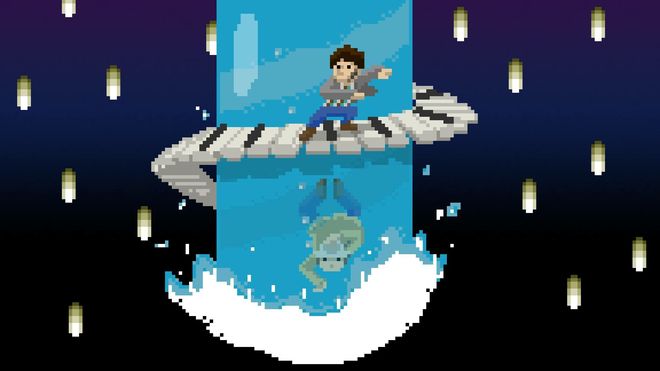
Nirvanna the Band the Show fan art by Matt "Roosterbark" Woodcock
Josh: We fell in love with it and were like, "How do we get this guy to work on the show?" Everyone thought it looked so amazing, such a fun, in the style of the show kind of thing. At the same time we were also workshopping that episode a little bit and it was trying to find its legs, like what things it would be parodying and what the story would be about. Those things kind of matched up, so we ended up contracting him to come in and work on it for about and month and change. He animated that sequence and a couple other sequences in that episode.
Nirvanna the Band the Show (2017) title sequence done in the style of Crank (2006)
Josh: It’s crazy how much detail is in that sequence, but it all goes by so fast that you don’t see any of it. We’re the ones who told him what to put in it and it took us six or seven watches to really get a handle on everything that’s in there. I think we still missed stuff in the background. Every frame is so dense with little references and characters. That guy’s style is insane. He does it all frame by frame, pixel by pixel in Photoshop.
Tristan: I absolutely adore that sequence.
Josh: It’s fun because with almost every single one of these titles we’re learning new skills. Like we need to figure out how to do pixel art and get that work. That’s all done by frames in Photoshop, so we have to figure out how to get that work and get the right framework in our thing. Or we do the fluid simulation for Daredevil, or matching film grain is the big thing for the Dog Day Afternoon and My Dinner with Andre sequences. We’ve also got to bring in new people and work with lot of talented artists we wouldn’t otherwise.
Is part of this poking fun of how trendy title sequences have become?
Matt: It’s tough to say because when we were doing this back in 2007 and we were very obsessed with it back then. But the idea of our show making fun of TV I think is dead on. I think the Westworld opening credits are a great example of a show that’s taking itself so seriously that you’re just like, “Come on!” Daredevil is very similar, where its opening credit sequence, for the most part, is so insanely humourless. They’re like, “You are about to watch the greatest show in the world,” and they’re having these VFX companies spend like… What do you think the buy on this Daredevil sequence was? They’re like million dollar credit sequences. Come on!
It’s unbelievable that shows are willing to go that far to market themselves, but it’s great for us because we don’t have any of those kinds of resources. The fact that we can approximate it and still be like, “Ahaha we’re just like you!” We can do all the things just like you even though we’re broke. It’s really exciting and also thematically very on point with the show. We go out and we’ll just do whatever we can, like our characters, to get the show or achieve their short-term goals, it’s very much in keeping with that. We don’t have permission? It’s okay we’ll just take it.
Comparison: Nirvanna the Band the Show episode 8 title sequence (left) and the My Dinner with Andre title sequence (right)
Jay: It’s nice to surprise people too with the bar we set for doing these things. They really juxtapose what the meat of the show is with the two-camera shoot, highly improvised, and talking over each other. Upon first watch you might get the sense that these guys are just throwing this together.
Matt: And that there’s no thinking...
Jay: And that there’s no thinking behind it. Then once you get to know the show, it’s like, “No, they’re actually setting the bar pretty high. This is all very calculated.”
Matt: At the very least it creates confusion. Because you don’t believe that the same people who could do this sequence would also be okay with forty minutes of two idiots in a living room playing piano just saying nonsense. How do those things go together? For the people who like the show, they can really get into that type of mashing up, that collision. You don’t normally see that. Shows that are intentionally shot like shit but let you know “We could make this look incredible but we don’t.”
Jay: It’s a nice game. As soon as we started it, we knew if we were going to choose a credit sequence then we’d pretty much have do as one-to-one, never do a scrappy version of a parody.
Matt: Yeah, we can’t cheap out! The consensus and expectation on work in this office is so high. Tristan’s expectation for his work is higher than mine and he’s the one delivering it. That just creates a culture of, “Okay, we really do have to get this right and we’re not gonna make excuses for it.”
You spoke a little bit about fair use earlier. Does it basically all come down to how short you keep the sequences?
Matt: Well, it’s more complicated than that. It’s the same way that we use all of the licensed material in the show. It’s the same kind of argument for that we would have to use John Williams’ music in our pilot or John Williams’ music in episode four, or maybe some of the John Williams music in episode three.
Jay: We’re still slightly limited with parody law and fair use.
Matt: Basically so long as what you’re doing is helping you tell your story and not overstaying its welcome then you’re okay. We have our own lawyer. The same lawyer who did all of the stuff for Operation Avalanche, made all of that stuff legal.
Basically so long as what you’re doing is helping you tell your story and not overstaying its welcome, then you’re okay.
Operation Avalanche (2016) trailer
Are you ever worried that people who aren’t hardcore cinephiles won’t get all these references?
Jay: Remember when you were young and you watched The Simpsons? Did you get every reference? Growing up you would realize, you’d see a movie for the first time and go “My god! The Simpsons did this!” That’s why that scene had that something to it. It never made me feel like I was outside or not getting what was going on in The Simpsons, I was just like what an interesting stylistic choice, they’re just getting weird. It’s fun.
Matt: And our show isn’t Documentary Now. We aren’t making a show that is about the parody of these things. The Simpsons is a great reference. It’s just part of set dressing. We use references and we use these opening credit sequences to service our story, not the other way around. We’re not trying to make an entire episode about the show Daredevil or about My Dinner with Andre; we’re just stealing as much as we can for the story of Matt and Jay and Nirvanna the Band. You can watch our show and know none of this stuff and still follow the journey of these two guys trying to get a show at the Rivoli. So we’ve never thought a reference is too obscure. There are some references in that Daredevil episode that are some of the most obscure references that we’ve ever done. Weird references to like fighting video games that nobody has played. I don’t think it detracts from it at all.
Tristan: It makes it oddly familiar too, because you’re just comfortable with it, the type of thing that you grow up with and you discover it later.
Comparison: Nirvanna the Band the Show episode 7 title sequence (left) and the Dog Day Afternoon opening (right)
What makes these parodies more attractive or fun than creating a original title sequences?
Jay: No matter what your role is in the title sequence, everyone is just setting a high bar and reviewing what it is that we’re doing so they get it right. For me, most of the time it’s just making sure that, if I’m acting, like in the Entourage thing, I’m just really studying that Entourage opening credits to know what they’re doing inside the car. Everyone’s doing their job, trying to pick up on the little things and one up each other, to try to find how close we can get to it so we’re acting and putting the same faces on, sitting in the same position. Was his arm up on the window or was it down here? What side was the phone on? It’s just a fun way to keep it going authentically.
Tristan: I only like doing projects that make me feel uncomfortable and where I feel like I’m going to fail every single day. Those are the ones that are the best for me to be working on and this was certainly that. It was the first time that project was presented to me and I had to copy something, make an attempt at a facsimile. That’s something that I’ve never done before. I wasn’t keen on that at first, but the more I got to nerd out and the more research I did, the more I was appreciative of other people’s abilities. Miguel and his team, the fluid simulations that they did are amazing and I’m glad I could get to a certain point where it looks relatively close.
Were there any sequences that you really wanted to do this season but didn’t fit with any of your stories?
Matt: We did all the ones that we really wanted to do. Game of Thrones. We still want to do it in season two or season three.
Jay: A Toronto version of Game of Thrones would just be so cool.
A Toronto version of Game of Thrones would just be so cool.
Game of Thrones (2011) main titles, designed by Elastic
Matt: Exactly, we wanted to do the overall map of Toronto as though it was the Game of Thrones game board and we just didn’t have the episode to do it, but we’re going on so we’ll do it later we hope. It’s going to be the Daredevil sequence of whatever that season is.
The one that takes more time than all the other sequences put together…
Matt: Yes, way more.
What were some surprises you encountered while working on these openings?
Matt: It was a surprise how much fuckin’ work that Entourage sequence was, having to drive around with that car rig all night!
Jay: Yeah, that was fun, having the camera set up with the suction cups.
Matt: Yeah, but you didn’t have to drive! Imagine driving with a five foot pole sticking out the door, and I’m doing loops on Queen Street.
What are some of your favourite title sequences?
Matt: Of all time? Not to go back to Game of Thrones, but it’s weird, the first time I saw Game of Thrones I was like, “This sucks. It’s so stupid, the song is stupid, the board is stupid,” and now I’m like, “This is the greatest!” I could just watch it on a loop forever. For movies there’s hundreds. Look at The Dirties, those are all my favorite opening credit sequences, for the most part. Especially first couple, like Hackers, Fight Club.
Josh: Billion Dollar Brain, Cowboy Bebop, Enter the Void, Joseph Kahn's Detention, the fan version of The Adventures of Tintin, Lupin the Third: A Woman Called Fujiko Mine.
Tristan: Anything Saul Bass. Early James Bond.
Matt: I don’t like the new Bond sequences. Catch Me If You Can would be top five.
Nirvanna the Band the Show (2017) season one trailer

